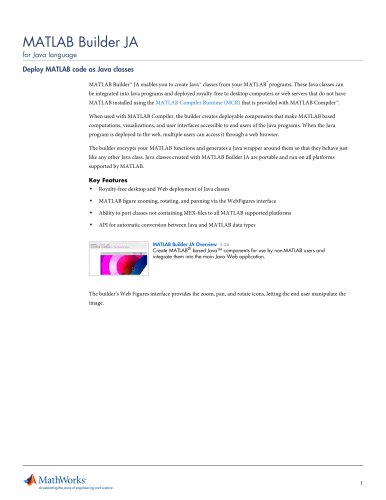
Catalog excerpts
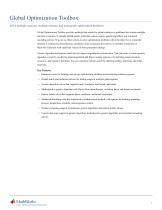
Global Optimization Toolbox Solve multiple maxima, multiple minima, and nonsmooth optimization problems Global Optimization Toolbox provides methods that search for global solutions to problems that contain multiple maxima or minima. It includes global search, multistart, pattern search, genetic algorithm, and simulated annealing solvers. You can use these solvers to solve optimization problems where the objective or constraint function is continuous, discontinuous, stochastic, does not possess derivatives, or includes simulations or black-box functions with undefined values for some parameter settings. Genetic algorithm and pattern search solvers support algorithmic customization. You can create a custom genetic algorithm variant by modifying initial population and fitness scaling options or by defining parent selection, crossover, and mutation functions. You can customize pattern search by defining polling, searching, and other functions. Key Features ▪ Interactive tools for defining and solving optimization problems and monitoring solution progress ▪ Global search and multistart solvers for finding single or multiple global optima ▪ Genetic algorithm solver that supports linear, nonlinear, and bound constraints ▪ Multiobjective genetic algorithm with Pareto-front identification, including linear and bound constraints ▪ Pattern search solver that supports linear, nonlinear, and bound constraints ▪ Simulated annealing tools that implement a random search method, with options for defining annealing process, temperature schedule, and acceptance criteria ▪ Parallel computing support in multistart, genetic algorithm, and pattern search solvers ▪ Custom data type support in genetic algorithm, multiobjective genetic algorithm, and simulated annealing solvers
Open the catalog to page 1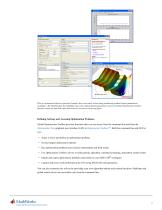
Plot of a nonsmooth objective function (bottom) that is not easily solved using traditional gradient-based optimization techniques. The Optimization Tool (middle) shows the solution found using pattern search in Global Optimization Toolbox. Iterative results for function value and mesh size are shown in the top figure. Defining, Solving, and Assessing Optimization Problems Global Optimization Toolbox provides functions that you can access from the command line and from the Optimization Tool graphical user interface (GUI) in Optimization Toolbox™. Both the command line and GUI let you: ▪...
Open the catalog to page 2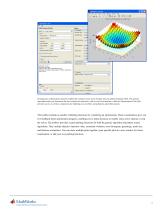
Rle Edil View Insert Tools Cesttop Window Help Sohef: ga ■ Genetic ilgorithm Unwr HKJUsiites: Run softer and view resUG Q Us* random stflbtt from previous run f^irmrfliign njwwig. Objective lumbon value: aOKSTlSWSr'HlH Qpannaasn tefmnated:average J-ar^enrtis FmetsvaLeletithan PopuLaton type: Dou^e SelKbOn r\rt(JWn: S1ftt-h»*C irtfpffil Crossover fraction 0 Ust deftxic 0 3 Visualization ofRastrigin's function (right) that contains many local minima and one global minimum (0,0). The genetic algorithm helps you determine the best solution for functions with several local minima, while the...
Open the catalog to page 3
Run-time visualizations (right) generated while the function is being optimized using genetic algorithm plot functions selected in the Optimization Tool (left). Using the output function, you can write results to files, create your own stopping criteria, and write your own application-specific GUIs to run toolbox solvers. When working from the Optimization Tool, you can export the problem and algorithm options to the MATLAB workspace, save your work and reuse it in the GUI at a later time, or generate MATLAB code that captures the work you've done. function...
Open the catalog to page 4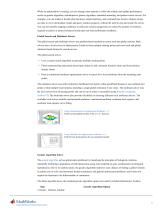
While an optimization is running, you can change some options to refine the solution and update performance results in genetic algorithm, multiobjective genetic algorithm, simulated annealing, and pattern search solvers. For example, you can enable or disable plot functions, output functions, and command-line iterative display during run time to view intermediate results and query solution progress, without the need to stop and restart the solver. You can also modify stopping conditions to refine the solution progression or reduce the number of iterations required to achieve a desired...
Open the catalog to page 5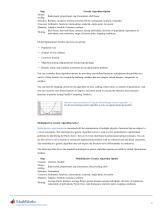
Step Genetic Algorithm Option Fitness Rank-based, proportional, top (truncation), shift linear scaling Selection Roulette, stochastic uniform selection (SUS), tournament, uniform, remainder Crossover Arithmetic, heuristic, intermediate, scattered, single-point, two-point Mutation Adaptive feasible, Gaussian, uniform Best fitness, best individual, distance among individuals, diversity of population, expectation of Plotting individuals, max constraint, range, selection index, stopping conditions Global Optimization Toolbox also lets you specify: ▪ Population size ▪ Number of elite children ▪...
Open the catalog to page 6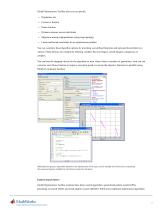
Global Optimization Toolbox also lets you specify: ■ Distance measure across individuals ■ Migration among subpopulations (using ring topology) ■ Linear and bound constraints for an optimization problem You can customize these algorithm options by providing user-defined functions and represent the problem in a variety of data formats, for example by defining variables that are integers, mixed integers, categorical, or You can base the stopping criteria for the algorithm on time, fitness limit, or number of generations. And you can vectorize your fitness function to improve execution speed...
Open the catalog to page 7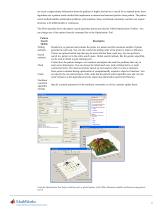
use exact or approximate information about the gradient or higher derivatives to search for an optimal point, these algorithms use a pattern search method that implements a minimal and maximal positive basis pattern. The pattern search method handles optimization problems with nonlinear, linear, and bound constraints, and does not require functions to be differentiable or continuous. The following table shows the pattern search algorithm options provided by Global Optimization Toolbox. You can change any of the options from the command line or the Optimization Tool. Pattern Search Option...
Open the catalog to page 8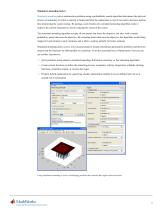
Simulated Annealing Solver Simulated annealing solves optimization problems using a probabilistic search algorithm that mimics the physical process of annealing, in which a material is heated and then the temperature is slowly lowered to decrease defects, thus minimizing the system energy. By analogy, each iteration of a simulated annealing algorithm seeks to improve the current minimum by slowly reducing the extent of the search. The simulated annealing algorithm accepts all new points that lower the objective, but also, with a certain probability, points that raise the objective. By...
Open the catalog to page 9All The MathWorks catalogs and technical brochures
-
MATLAB Production Server
6 Pages
-
Database Toolbox
4 Pages
-
MATLAB Report Generator
4 Pages
-
Stateflow
8 Pages
-
SimEvents
7 Pages
-
SimDriveline
7 Pages
-
SimHydraulics
7 Pages
-
SimPowerSystems
8 Pages
-
Simulink Control Design
5 Pages
-
Aerospace Blockset
5 Pages
-
SimRF
6 Pages
-
Simulink Coder
6 Pages
-
Embedded Coder
8 Pages
-
Simulink PLC Coder
4 Pages
-
Fixed-Point Designer
9 Pages
-
MATLAB Coder
5 Pages
-
Simulink 3D Animation
10 Pages
-
Gauges Blockset
2 Pages
-
Simulink Report Generator
3 Pages
-
Polyspace Bug Finder
6 Pages
-
Phased Array System Toolbox
9 Pages
-
OPC Toolbox
5 Pages
-
Simulink Design Verifier
7 Pages
-
Simulink Design Optimization
10 Pages
-
Filter Design HDL Coder
5 Pages
-
Bioinformatics Toolbox
9 Pages
-
SimBiology
6 Pages
-
Computer Vision System Toolbox
10 Pages
-
DSP System Toolbox
11 Pages
-
Fuzzy Logic Toolbox
5 Pages
-
Polyspace Client for C/C++
5 Pages
-
xPC Target
5 Pages
-
SimMechanics
7 Pages
-
Simscape
7 Pages
-
Simulink
6 Pages
-
Data Acquisition Toolbox
8 Pages
-
Image Processing Toolbox
7 Pages
-
Signal Processing Toolbox
10 Pages
-
Control System Toolbox
6 Pages
-
Symbolic Math Toolbox?
6 Pages
-
Parallel Computing Toolbox?
7 Pages
-
MATLAB®
6 Pages
-
Mapping Toolbox 3.2
7 Pages
-
Instrument Control Toolbox
7 Pages
-
Optimization Toolbox 6.0
14 Pages
Archived catalogs
-
MATLAB Release Notes
505 Pages
-
C and Fortran API Reference
263 Pages
-
External Interfaces
649 Pages
-
Function Reference: Volume 3 (P-Z)
1696 Pages
-
Function Reference: Volume 2 (F-O)
1568 Pages
-
Function Reference: Volume 1 (A-E)
1298 Pages
-
Creating Graphical User Interfaces
520 Pages
-
3-D Visualization
212 Pages
-
Graphics
667 Pages
-
MATLAB Programming Tips
66 Pages
-
Programming Fundamentals
840 Pages
-
Data Analysis
220 Pages
-
Mathematics
316 Pages
-
MATLAB® Getting Started Guide
250 Pages



